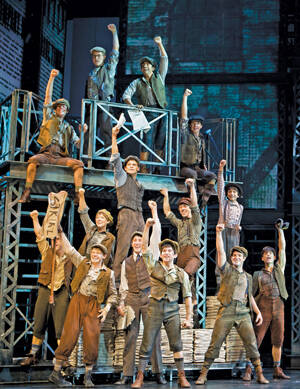Extra! Extra! Read all about it! Hollywood Flop Becomes Broadway Sensation!” That headline is what the producers hoped for as Newsies: The Musical arrived in April to “occupy Broadway.”
The play is based on a working-class rebellion in 1899 during which thousands of newsboys went on strike against the media titans of their day, William Randolph Hearst and Joseph Pulitzer. Now, as high unemployment persists and workers’ wages and benefits are cut, the labor theme is especially timely. Audiences will also relate to the power of media moguls to squeeze from the lowliest workers an extra penny of profit.
The Broadway production is a revised version of the 1992 Disney film, “Newsies.” Even though the film featured the future Academy Award winner Christian Bale, with music by Alan Menken, who would also go on to win numerous Oscars, it was a box-office failure. It appeared between two other Disney blockbuster films, both animated musicals, “Beauty and the Beast” (1991) and “The Lion King” (1994), but the live-action musical found no comparable audience. Over the last 20 years, however, “Newsies” became a cult favorite in its VHS and DVD versions, which emboldened Disney to try the story again, this time on stage.
Disney Theatrical Productions has reason to hope the show will succeed on Broadway. “The Lion King” continues to play to full houses after 15 years. “Beauty and the Beast” ran for 13 years; “Mary Poppins” is now in its seventh year. But Disney has also had its share of theatrical failures. Neither “The Little Mermaid” nor “Tarzan” transferred well from screen to stage. So what are the chances for “Newsies?”
It has a lot going for it. Menken has added several new songs to those he wrote for the film. Harvey Fierstein, with four Tony Awards to his credit, has written the book, and another multi-award winner, Jeff Calhoun, is directing. And the play’s incarnation last autumn at the Paper Mill Playhouse in New Jersey was a hit, prompting The Wall Street Journal to call the Broadway production “one of the most anticipated musicals of the season.”
The Rise of Jeremy Jordan
Then there is the acting. In the role of Jack Kelly, the charismatic strike-leader, the show spotlights a genuine Broadway star-in-the-making, Jeremy Jordan. Therein lies a story. After the run of “Newsies” at Paper Mill, Jordan landed the lead role in the ill-fated musical version of “Bonnie and Clyde.” But as the gods of the theater would have it, that show closed within weeks, and Jordan was able to return to his role in “Newsies” for its Broadway run. Combining the looks of a young Brando and Gene Kelly, Jordan is the real deal. He owns the stage as the sensitive tough guy (Jack has hidden artistic talents) with a “Noo Yawk” mouth on him; he challenges the newspaper bigwigs, especially Pulitzer, and charms Katherine (Kara Lindsay), the bright young lady reporting on their strike.
Jordan is accompanied by a chorus of newsboys, who bring the same braggadocio and high-energy dancing the Jets and the Sharks brought to “West Side Story” years ago. The dancing, choreographed by Christopher Gattelli, is an exciting display with the gymnastics of forward and backward somersaults, balletic leaps and extended pirouettes. There is also a knockout tap performance to the liveliest song in the show, “King of New York.”
Many of the other musical numbers—perhaps inevitably—are anthems of unity or protest to accompany the newsboys’ struggle for decent wages. For these ragamuffins an additional penny in the price they must pay for every newspaper they sell is burden enough to drive them to go on strike.
“Carrying the Banner” is followed by “The World Will Know,” “Once and for All,” “Brooklyn’s Here” and “Seize the Day,” which is reprised twice. Even Katherine’s solo, “Watch What Happens,” gets an anthemic reprise when she sings it with Jack and some of the other newsboys. Fortunately, the songs are accompanied by more of the amazing dancing.
One might expect, however, a bit more variety in a score by Mencken, the composer behind “Little Shop of Horrors,” “Beauty and the Beast,” “Aladdin,” “The Hunchback of Notre Dame” and other popular Disney films. The same might be said for Harvey Fierstein. Lacking the wit and creativity of his award-winning plays “Torch Song Trilogy” and “La Cage aux Folles,” Fierstein’s dialogue ought to have presented the newsboys as more smart-alecky, the newspaper magnates as more cynical and the proto-feminist Katherine as feistier.
Ost’s Striking Set
One of the most successful elements of the production is Tobin Ost’s omnipresent metal scaffolding, which fills the entire back of the stage and serves as a set of fire-escapes, a rooftop, the newsboys’ dormitory and even the Brooklyn Bridge. Meanwhile, film projections behind the platforms contrast the New York skyline with the open desert sky of Santa Fe, where Jack dreams of going if he ever escapes his hardscrabble life in the cruel city. The projections also create the settings of the Newsboys Home, the deli that becomes their strike headquarters and the office of Pulitzer’s Evening World. And they display the magnified front pages of the newspapers covering the strike. The techno look and mobility of the scaffolding, along with the use of projections instead of scenery, fit the living and working conditions of the newsboys.
While the musical is “based on” real events, it takes considerable liberties with the facts. The newsboys never met with Joseph Pulitzer (John Dossett), there was no romance between the strike leader and a reporter, and Gov. Theodore Roosevelt (Kevin Carolan) did not intervene on their behalf. But who cares, when this new Broadway star and his gang are dancing their hearts out.








